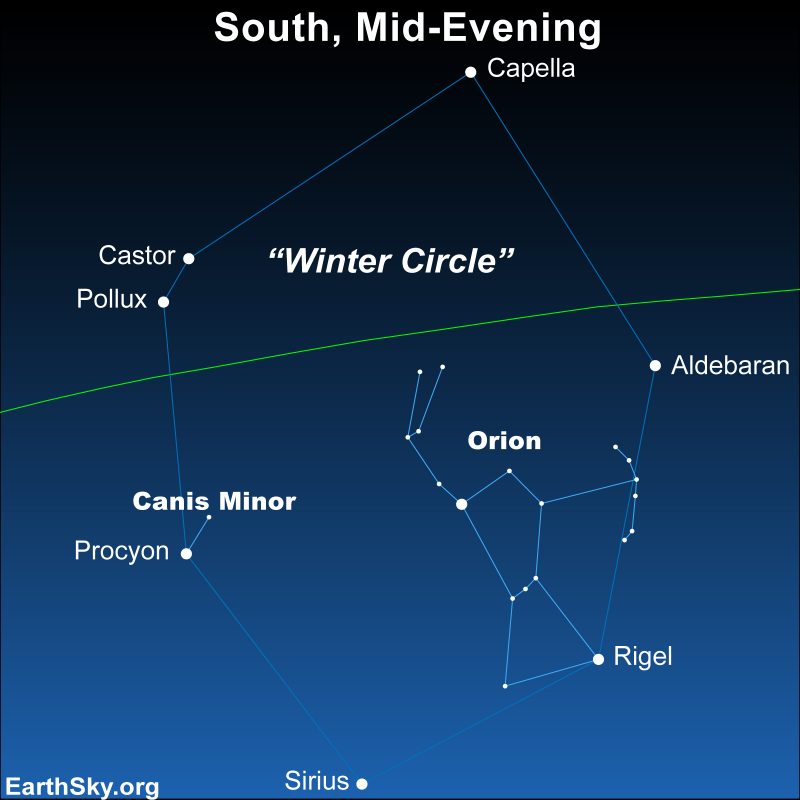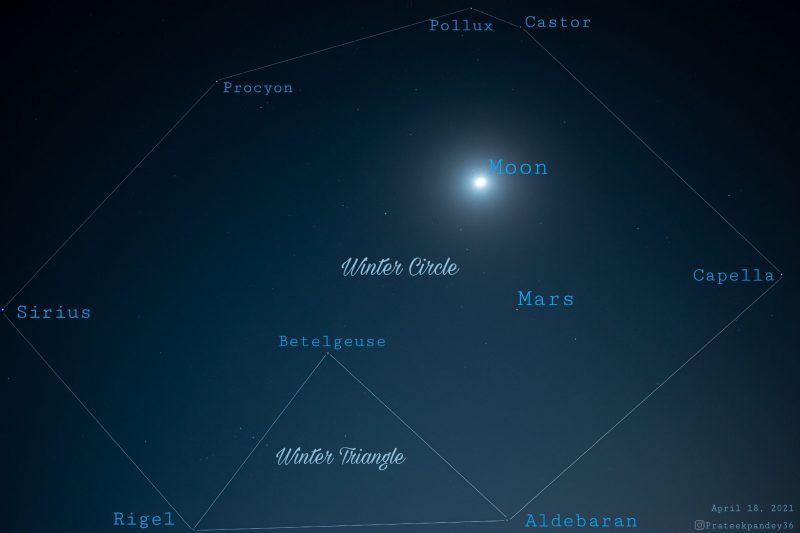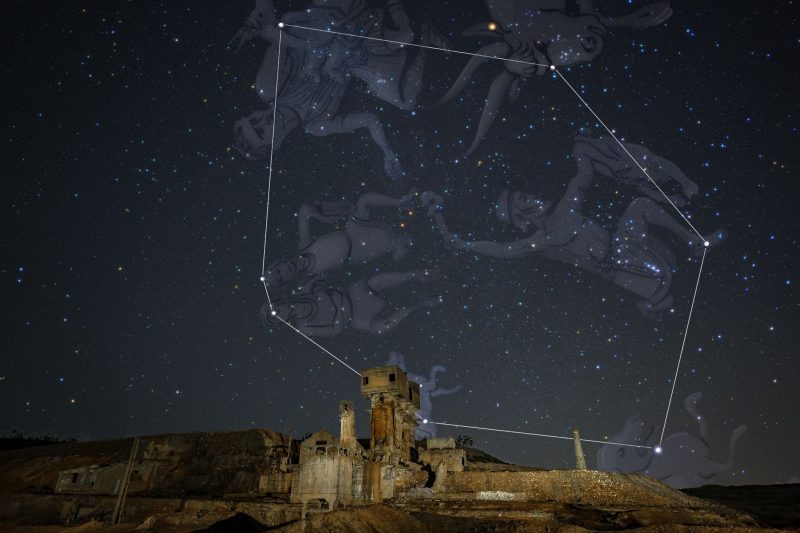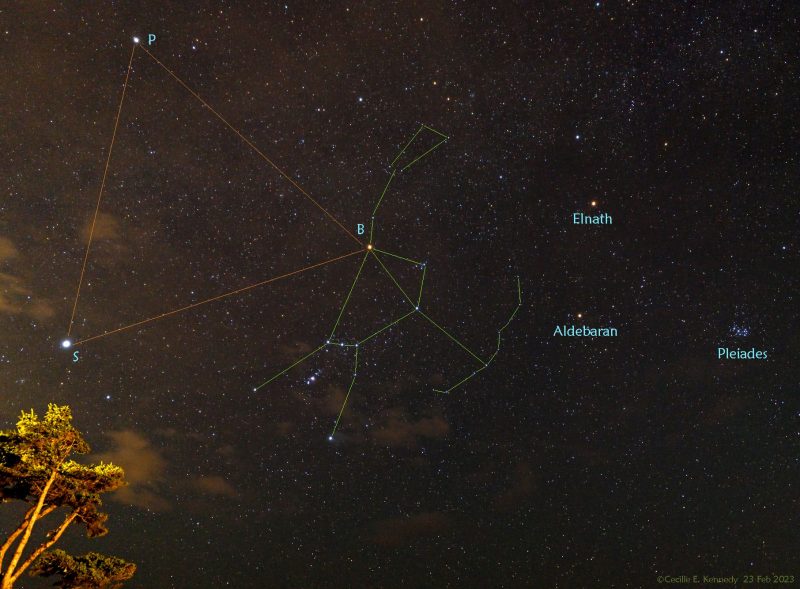
The Winter Hexagon asterism
The Winter Hexagon – aka the Winter Circle – is a collection of some of the brightest stars in the Northern Hemisphere’s winter sky. And the Southern Hemisphere’s summer sky. To clarify, the Winter Hexagon isn’t a constellation. It’s an asterism, or prominent group of stars that form a noticeable pattern. In addition, the Winter Hexagon has a smaller asterism inside it, called the Winter Triangle.
The Winter Hexagon is big! It’s made of six 1st-magnitude stars from six different constellations: Rigel in Orion the Hunter, Aldebaran in Taurus the Bull, Capella in Auriga the Charioteer, Pollux in Gemini the Twins, Procyon in Canis Minor the Lesser Dog and Sirius in Canis Major the Greater Dog. Also, an additional 1st-magnitude star, Betelgeuse in Orion the Hunter, lies toward the center of the Hexagon.

2024 lunar calendars on sale now. Makes a great gift! Check it out here.
When is the Winter Hexagon (or Circle) visible?
So, like all stars, those in the Winter Hexagon rise and set some four minutes earlier with each passing night. Indeed, by late January, the Winter Hexagon will have risen high enough above the northeastern horizon so it’s visible by about 7 p.m. local time. Then, if you look around midnight, the Winter Hexagon will be high above the southern horizon. And later, after about 3 a.m. local time, it sinks toward the southwestern horizon, with some of it setting in the west before sunrise.
Then, in late February and early March, the Winter Hexagon is in your southern sky at nightfall and early evening.

Finding the Winter Hexagon
First, to find the Winter Hexagon or Circle, find the easily recognizable constellation of Orion the Hunter. Indeed, its three belt stars give it away. Then, look for the bright bluish star to the lower right. This star is Rigel, the southwest corner of the Winter Circle and the first of the six stars in the Hexagon. By the way, Rigel is the brightest star in Orion and the seventh brightest star in the night sky.
Now draw a line through Orion’s Belt stars upward to find Aldebaran, the ruddy eye of Taurus the Bull. Aldebaran is the second star in the Hexagon and the brightest star in Taurus. As a matter of fact, Aldebaran is the fourteenth brightest star in the sky.
Next, continue upward in a counterclockwise direction to find the next bright star, Capella in Auriga the Charioteer. Capella is the third star on our journey and the northernmost point of the Winter Hexagon. In fact, Capella is the sixth brightest star in the heavens.
Completing the Hexagon
Then, as we start to wind down the other side of the hexagon, we run into two bright stars, the Twins Stars in Gemini the Twins. Pollux, the brighter of the two, is our fourth corner in the hexagon, and you’ll notice its “twin,” Castor, is just a bit fainter. Pollux is the sky’s 17th brightest star, and Castor is the 24th.
Our second-to-last stop around the Winter Hexagon is the bright star below the Twins Stars, Procyon. Procyon is the brightest star in Canis Minor the Lesser Dog, and in fact one of only two named stars in the constellation. For such a “minor” constellation, Procyon shines brilliantly as the seventh brightest star in the sky.
Finally, we come down to the southernmost star in the Winter Hexagon and the brightest of them all: Sirius in Canis Major the Greater Dog. Sirius is the brightest star in the Winter Hexagon and in the entire night sky. In fact, only the moon and some planets can outshine Sirius.
Finding the Winter Triangle
After you’ve found the Winter Hexagon, look inside it to find another asterism. That’s the Winter Triangle. First, take the last two stars of the Hexagon, Sirius and Procyon, then head toward the center of the Hexagon. That’s where you’ll find reddish star Betelgeuse, marking the shoulder of Orion. Betelgeuse makes the third corner of the Winter Triangle. Betelgeuse is the 10th brightest star in the sky and second brightest star in Orion.


The Hexagon is big and contains areas of the Milky Way
Furthermore, to get an idea of the Hexagon’s humongous size, the span from the southernmost star, Sirius, to the northernmost star, Capella, covers about 1/3 of the dome of the sky.
Then for a bonus, on a dark and clear moonless night, you can see the soft-glowing river of stars that we call the Milky Way meandering right through the center of the Winter Hexagon.
Bottom line: The Winter Hexagon is a giant shape made from some of the brightest stars in the sky, including Rigel, Aldebaran, Capella, Pollux, Procyon and Sirius.
Enjoying EarthSky? Sign up for our free daily newsletter today!
The post How to find the Winter Hexagon or Winter Circle first appeared on EarthSky.
from EarthSky https://ift.tt/Pey20Xm

The Winter Hexagon asterism
The Winter Hexagon – aka the Winter Circle – is a collection of some of the brightest stars in the Northern Hemisphere’s winter sky. And the Southern Hemisphere’s summer sky. To clarify, the Winter Hexagon isn’t a constellation. It’s an asterism, or prominent group of stars that form a noticeable pattern. In addition, the Winter Hexagon has a smaller asterism inside it, called the Winter Triangle.
The Winter Hexagon is big! It’s made of six 1st-magnitude stars from six different constellations: Rigel in Orion the Hunter, Aldebaran in Taurus the Bull, Capella in Auriga the Charioteer, Pollux in Gemini the Twins, Procyon in Canis Minor the Lesser Dog and Sirius in Canis Major the Greater Dog. Also, an additional 1st-magnitude star, Betelgeuse in Orion the Hunter, lies toward the center of the Hexagon.

2024 lunar calendars on sale now. Makes a great gift! Check it out here.
When is the Winter Hexagon (or Circle) visible?
So, like all stars, those in the Winter Hexagon rise and set some four minutes earlier with each passing night. Indeed, by late January, the Winter Hexagon will have risen high enough above the northeastern horizon so it’s visible by about 7 p.m. local time. Then, if you look around midnight, the Winter Hexagon will be high above the southern horizon. And later, after about 3 a.m. local time, it sinks toward the southwestern horizon, with some of it setting in the west before sunrise.
Then, in late February and early March, the Winter Hexagon is in your southern sky at nightfall and early evening.

Finding the Winter Hexagon
First, to find the Winter Hexagon or Circle, find the easily recognizable constellation of Orion the Hunter. Indeed, its three belt stars give it away. Then, look for the bright bluish star to the lower right. This star is Rigel, the southwest corner of the Winter Circle and the first of the six stars in the Hexagon. By the way, Rigel is the brightest star in Orion and the seventh brightest star in the night sky.
Now draw a line through Orion’s Belt stars upward to find Aldebaran, the ruddy eye of Taurus the Bull. Aldebaran is the second star in the Hexagon and the brightest star in Taurus. As a matter of fact, Aldebaran is the fourteenth brightest star in the sky.
Next, continue upward in a counterclockwise direction to find the next bright star, Capella in Auriga the Charioteer. Capella is the third star on our journey and the northernmost point of the Winter Hexagon. In fact, Capella is the sixth brightest star in the heavens.
Completing the Hexagon
Then, as we start to wind down the other side of the hexagon, we run into two bright stars, the Twins Stars in Gemini the Twins. Pollux, the brighter of the two, is our fourth corner in the hexagon, and you’ll notice its “twin,” Castor, is just a bit fainter. Pollux is the sky’s 17th brightest star, and Castor is the 24th.
Our second-to-last stop around the Winter Hexagon is the bright star below the Twins Stars, Procyon. Procyon is the brightest star in Canis Minor the Lesser Dog, and in fact one of only two named stars in the constellation. For such a “minor” constellation, Procyon shines brilliantly as the seventh brightest star in the sky.
Finally, we come down to the southernmost star in the Winter Hexagon and the brightest of them all: Sirius in Canis Major the Greater Dog. Sirius is the brightest star in the Winter Hexagon and in the entire night sky. In fact, only the moon and some planets can outshine Sirius.
Finding the Winter Triangle
After you’ve found the Winter Hexagon, look inside it to find another asterism. That’s the Winter Triangle. First, take the last two stars of the Hexagon, Sirius and Procyon, then head toward the center of the Hexagon. That’s where you’ll find reddish star Betelgeuse, marking the shoulder of Orion. Betelgeuse makes the third corner of the Winter Triangle. Betelgeuse is the 10th brightest star in the sky and second brightest star in Orion.


The Hexagon is big and contains areas of the Milky Way
Furthermore, to get an idea of the Hexagon’s humongous size, the span from the southernmost star, Sirius, to the northernmost star, Capella, covers about 1/3 of the dome of the sky.
Then for a bonus, on a dark and clear moonless night, you can see the soft-glowing river of stars that we call the Milky Way meandering right through the center of the Winter Hexagon.
Bottom line: The Winter Hexagon is a giant shape made from some of the brightest stars in the sky, including Rigel, Aldebaran, Capella, Pollux, Procyon and Sirius.
Enjoying EarthSky? Sign up for our free daily newsletter today!
The post How to find the Winter Hexagon or Winter Circle first appeared on EarthSky.
from EarthSky https://ift.tt/Pey20Xm

Aucun commentaire:
Enregistrer un commentaire